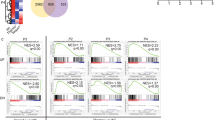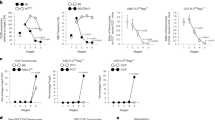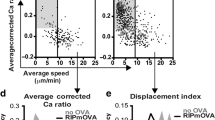Abstract
The intrathymic differentiation process by which precursor cells derived from the bone marrow develop into immune-competent T lymphocytes is poorly understood. Most thymocytes express both CD4 and CDS accessory molecules1, yet little is known about either the function of these molecules or the responsiveness of the CD4+8+ double positive thymocytes that bear them2–7. Here, we address the possibility that CD4 engagement influences T-cell receptor (TCR) expression on developing thymocytes. We engaged CD4 molecules on murine thymocytes by in vivo injection of an anti-CD4 monoclonal antibody, which reduced the surface expression of CD4 on CD4+ thymocytes. More importantly, CD4 engagement also affected TCR expression on CD4+ thymocytes, but the effect on CD4+8+ double positive and CD4+8- single positive thymocytes was very different. CD4+8+ thymocytes responded to CD4 engagement by dramatically increasing surface expression of TCR, whereas CD4+8- thymocytes decreased surface expression of TCR. These results demonstrate that the effect of CD4 engagement on TCR expression is dependent upon the developmental state of the responding thymocyte, and, most interestingly, results in increased TCR expression by double positive thymocytes.
This is a preview of subscription content, access via your institution
Access options
Subscribe to this journal
Receive 51 print issues and online access
$199.00 per year
only $3.90 per issue
Buy this article
- Purchase on Springer Link
- Instant access to full article PDF
Prices may be subject to local taxes which are calculated during checkout
Similar content being viewed by others
References
Fowlkes, B. J., Edison, E., Mathieson, B. J. & Chused, T. M. J. exp. Med. 162, 802–888 (1985).
Reinherz, E. L. & Schlossman, S. F. Cell 19, 821–827 (1980).
Shortman, K. & Jackson, H. Cell. Immun. 12, 230–246 (1974).
McPhee, D., Pye, J. & Shortman, K. Thymus 1, 151–162 (1979).
Havran, W. L. et al. Nature 330, 170–173 (1987).
Finkel, T. H., McDuffie, M., Kappler, J. W., Marrack, P. & Cambier, J. C. Nature 330, 179–181 (1987).
McDuffie, M., Born, W., Marrack, P. & Kappler, J. Proc. natn. Acad. Sci. U.S.A. 83, 8728–8732 (1986).
Biddison, W. E., Rao, P. A., Talle, M. A., Goldstein, G. & Shaw, S. J. exp. Med. 156, 1065–1076 (1982).
Swain, S. Immunol. Rev. 74, 129–142 (1983).
MacDonald, H. R., Glasebrook, A. L., Bron, C., Kelso, A. & Cerottini, J.-C. Immunol. Rev. 68, 89–115 (1982).
Greenstein, J. L., Kappler, J., Marrack, P. & Burakoff, S. J. J. exp. Med. 159, 1213–1224 (1984).
Golding, H. et al. Nature 317, 425–428 (1985).
Doyle, C. & Strominger, J. L. Nature 330, 256–259 (1987).
Bluestone, J. A., Pardoll, D., Sharrow, S. O. & Fowlkes, B. J. Nature 326, 82–84 (1987).
Crispe, I. N., Shimonkevitz, R. P., Husmann, L. A., Kimura, J. & Allison, J. P. J. Immun. 139, 3585–3589 (1987).
Kruisbeek, A. M., Fultz, M. J., Sharrow, S. O., Singer, A. & Mond, J. J. J. exp. Med. 157, 1932–1946 (1983).
Kruisbeek, A. M. et al. J. exp. Med. 161, 1029–1047 (1985).
Mizuochi, T., Tentori, L., Sharrow, S. O., Kruisbeek, A. M. & Singer, A. J. exp. Med. 168, 437–442 (1988).
Dialynas, D. P. et al. J. Immun. 131, 2445–2451 (1983).
Leo, O., Foo, M., Sachs, D. H., Samelson, L. E. & Bluestone, J. A. Proc. natn. Acad. Sci. U.S.A. 84, 1374–1378 (1987).
Staerz, U. D., Rammensee, H.-G., Benedetto, J. D. & Bevan, M. J. J. Immun. 134, 3994–4000 (1985).
Lanier, L. L., Gutman, G. A., Lewis, D. E., Griswold, S. T. & Warner, N. L. Hybridoma 1, 125–131 (1982).
Sarmiento, M., Glasebrook, A. L. & Fitch, F. W. J. Immun. 125, 2665–2672 (1980).
Janeway, C. A. Jr et al. J. immun. 132, 662–667 (1984).
Pierres, A. et al. J. Immun. 132, 2275–2785 (1984).
Author information
Authors and Affiliations
Rights and permissions
About this article
Cite this article
McCarthy, S., Kruisbeek, A., Uppenkamp, I. et al. Engagement of the CD4 molecule influences cell surface expression of the T-cell receptor on thymocytes. Nature 336, 76–79 (1988). https://doi.org/10.1038/336076a0
Received:
Accepted:
Issue Date:
DOI: https://doi.org/10.1038/336076a0
This article is cited by
-
The proline-rich sequence of CD3ε controls T cell antigen receptor expression on and signaling potency in preselection CD4+CD8+ thymocytes
Nature Immunology (2008)
-
Novel post-translational regulation of TCR expression in CD4+CD8+ thymocytes influenced by CD4
Nature (1990)
-
Distinct sequence of negative or positive selection implied by thymocyte T-cell receptor densities
Nature (1990)
-
Correlation between the Vß4+CD8+ T-cell population and theH-2 d haplotype
Immunogenetics (1990)
-
Intrathymic signalling in immature CD4+ CD8+ thymocytes results in tyrosine phosphorylation of the T-cell receptor zeta chain
Nature (1989)
Comments
By submitting a comment you agree to abide by our Terms and Community Guidelines. If you find something abusive or that does not comply with our terms or guidelines please flag it as inappropriate.



